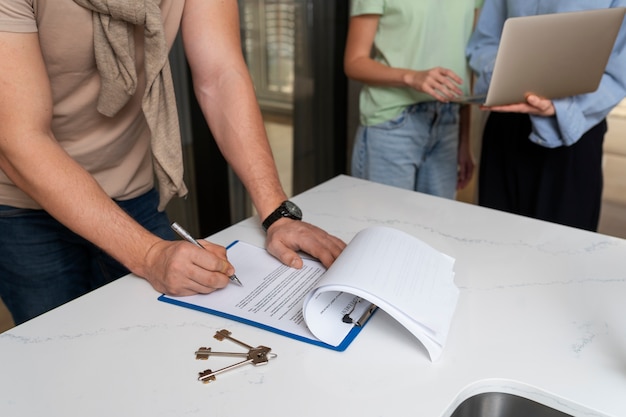1010 W. St. Germain Street,
Suite 250
St. Cloud, MN 56301
(320) 257-8600
HISTORIC DOWNTOWNSt Cloud Added to the Preserve America Community by Form er First Lady
er First Lady
The City of St. Cloud has another feather for its preservation hat. In April 2005, the City was notified that First Lady Laura Bush had designated St. Cloud as one of the country’s newest Preserve America communities.
Download a .pdf of the Downtown Historic Walking Brochure (front side, back side)
(or)
Send an to request a copy of the Downtown Historic Walking Brochure.
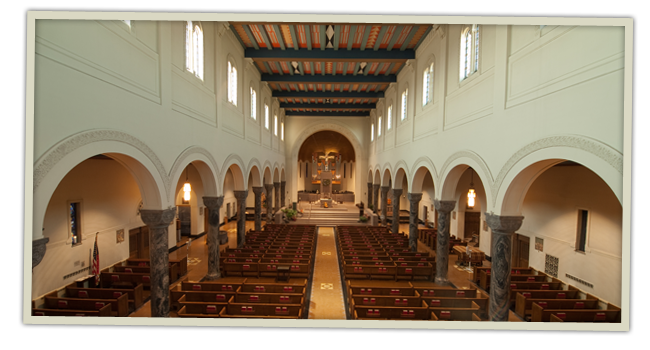
Information Links and Resources
Heritage Preservation Commission
Preservation FAQ’s
Downtown Preservation Design Manual
Stearns History Museum
Minnesota History Center
National Trust for Historic Preservation
Its not about the buildings, but the people that built and occupied them.
John L. Wilson

St. Germain Street –The Beginning
In the 1850s, St. Cloud was a collection of three tiny villages; 1) Upper Town, (Acadia) settled by southerners who brought servants from Tennessee, 2) Lower Town, known as “Protestant, temperance-loving Yankee merchants” who patronized the Stearns House, a Gothic Revival Style hotel located on the St. Cloud Normal School Campus (circa 1890) which is now St. Cloud State University, and 3) Middle Town. In 1853, a Yankee named John L. Wilson paid $100-$250 for Ole Bergeson’s 320-acre homestead in Middletown. Wilson sold and sometimes gave away frontage to men who intended to develop businesses. German Catholic tradesmen and shopkeepers who had read reports of life in Central Minnesota by an early missionary, Fr. Francis X Pierz, were attracted by Wilson’s offer.
Wilson was of French Huguenot descent and was a devotee of Napoleon and French history. Napoleon and his wife, Josephine, had a summer palace in St. Cloud, 16 miles outside of Paris. Wilson chose “St. Germain” for his main street probably in reference to Le Boulevard de Saint Germain, one of the main streets in Paris. St. Germain Street became the major corridor in Downtown St. Cloud because of it’s direct access to local trade routes.
Wilson’s town was settled principally by industrious German Catholics, including tradesmen and shopkeepers who had come to the area from Evansville, Indiana seeking a location for a German Colony.
George Fuller Brott was the developer of St. Cloud City (or Lower Town). Brott described himself as “farmer, wagon and carriage maker, real estate dealer, editor, townsite promoter, owner of flour mills, steamboats and sailing craft, merchant, member constitutional convention, colonel of engineers, canal and railroad president and inventor.” He died in Washington, DC in 1902. Brott also owned the first newspaper in St. Cloud, the Minnesota Advertiser.
McClure & Searle Buildings, 14-16 Fifth Avenue South
Robert J. Cromwell was the proprietor of the African Saloon & Barbership housed in this building, and was known as an educated and shrewd businessman. The upstairs portion is where a person would have shaved, shorn and shampooed. In March 1885, after too much “drink” and an argument over the Civil War, Cromwell’s home and business were destroyed, and he sustained personal injuries. A group of individuals were acquitted by a jury, but overturned by a judge, found guilty and fined. Later, Cromwell moved to Louisiana and became a State Legislator. This building once served as the offices to Tenvoorde Ford. One of the earlier and more unique local attractions of the mobile age was Steve Tenvoorde’s Bicycle Band. He fashioned special handlebars which held musical instruments to the bikes. In 1899, Tenvoorde was the proud co-owner (along with Peter Theilman) of St. Cloud’s first automobile. The following year, he closed the bicycle business in favor of cars. By 1905 the City sported 5 automobiles among its nearly 10,000 residents. Today, the City’s population is almost 64,000.
DB Searle Building, 18 Fifth Avenue South
A St. Cloud architect designed this red, pressed brick and granite-trimmed building in Victorian Commercial style to match the adjoining McClure Building. Dolson B. Searle (builder, lawyer and financier) knew Abraham Lincoln and was at Ford’s Theatre on April 14, 1865, that fateful night the President as assassinated. Slated for demolition in 1977, the building was remodeled and now is a popular downtown restaurant and bar. The construction cost estimates are $15,000.
Originally, the first story housed German National Bank with 14-foot ceilings, black walnut bank counters with a plate glass finish. Today, the bar is in front of where the teller windows were. The original flooring still covers the vestibule area.
A motley group followed the building’s original occupants. They included the advertising office and headquarters of the Pan Motor Co., a furniture store, a musicians’ association, piano tuning business, a tailor shop and the longest-lasting tenant was Colbert’s Funer Home (1940-70) which might be the inspiration for the ghost stores.
Paramormal Presence SCT 10-31-1900; 10-31-1991) General Manager Rachel Potucek was on the 3rd floor cleaning the dining area for the night when she watched as an ice cream scoop rose from the ice machine and floated 7 feet across the room, hung for a few seconds and dropped. Other accounts include hearing classical music from a radio without power; Bartender Vargason felt a hand push down her hair with no one around; mirrors that reflect people who are not there, ominous figures in the shadows and pounding on the walls.
Elks Home, 1913, 22-24 Fifth Avenue South
This building was constructed as an Elk Lodge and meeting hall. The front porch has three symbols of the Elks Society; 1) B.P.O.E. (Benevolent & Protective Order of Elks) is carved into the front steps. 2) The lodge number 516 references the 516th building constructed nationwide, and 3) Two clocks frozen at 11:00 serving as a reminder for all Elk members to pause at this time to remember fallen members (trademark of all Elk buildings).
Current owners are Dan and Mark Barth, oeprating a live theatre, a wine bar, coffee shop and video production company. The maple flooring, fireplace and mantels are all original to the building.
- “The King” is listed as one of the top 10 best urinals in the world according to Explore Minnesota Magazine. Located in the upstairs men’s restroom.
- The front porch is 100% original to the building (porch alone is unique to the downtown streetscape). In addition, it boosts four solid, polished granite pillars. When purchasing the building the inspector stated that, “…the four pillars were probablly worth more than what you paid for the entire building”.
Clark Brother’s Jeweler, 515-517 West St. Germain Street
This was the former home of Jones Candy Co., open for 39 years. Jones’ candies were “famous to all corners of the world” or so they said. Candyman Jones had built his reputation in the art of candy making 8 years before coming to St. Cloud in 1897. The Jones name, carved in granite, is still visible on the front of the present St. Cloud Floral building.
Thielman Hardware, 703 West St. Germain Street
Leonard Thielman moved here shortly after being discharged from the Civil War service. He had been a member of Co. B, 49th New York. The hardware store occupied the ground floor occupied the ground floor of the building from 1895-1947. Sullivan Law offices occupied the 2nd floor 1896-1905. J.D. Sullivan was elected state senator in 1910. He “dropped dead” while en route to his home on 4th Avenue South after spending a few hours at the Elks Club with friends at 5:30 pm on a Sunday; described as a very impressive human being, both personally and professionally.
Thomas Urbaniak came to American from Poland in about 1888, St. Cloud in about 1897. He was a tailor for over 50 years, occupying the 2nd floor from 1903-04. He was the last living member of the group that organized and built St. John Cantius church.
John Neimann Building, 805 West St. Germain Street
John Heimann was born in 1856 in Suderwich Recklinghausen, Germany, where he learned his building trade. He came to America at the age of 24 and settled in St. Cloud where he became one of the leading contractors and builders in the area. Some of the buildings he worked on include the St. Nicholas Church, St. Raphael’s Hospital, Carter Building, north wing of the Norman School (now St. Cloud State University), St. Joseph’s home and the Edelbrock building at 701 W. St. Germain Street.
Sherman Theatre & Breen Hotel, 913 West St. Germain Street
Now home to the Paramount Theatre and Germain Towers, which was completely restored in the 1990s. The theatre originally served as a vaudeville, film and legitimate theatre. Academy winning actor Gig Young, who grew up as Byron Barr in St. Cloud, ushered at the theatre. By the mid 60’s, the Paramount had fallen into disrepair and fell victim to fire on January 15, 1985. Today, over 80,000 people use the buiding each year.
Harriet Corbett
Wilson’s 2nd wife

George Fuller Brott
developer, Lower Town

Broker Block, destroyed by fire 1872

St. Germain, c. 1907
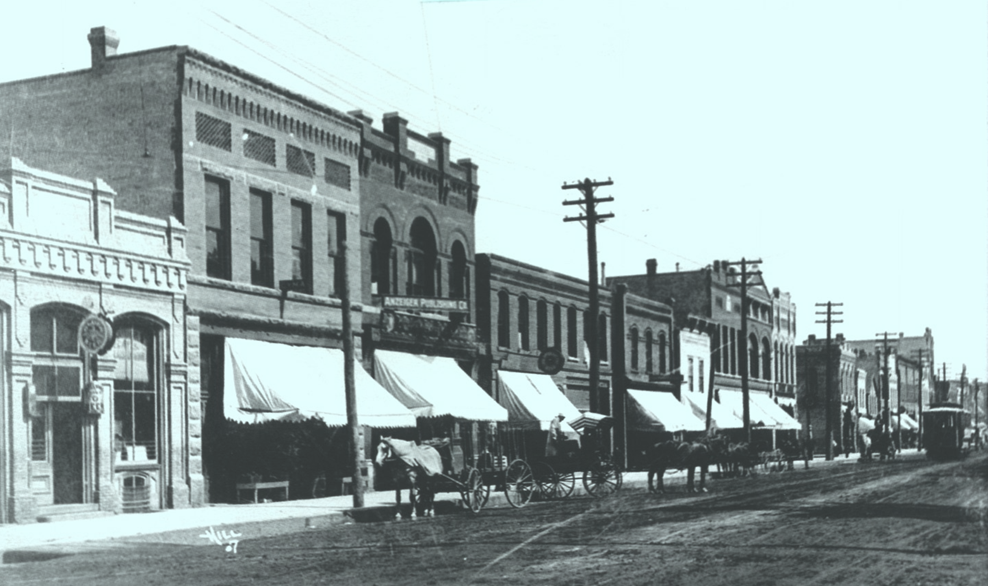
Micthell Building, 1885

Bensen Bros. Store, c. 1900
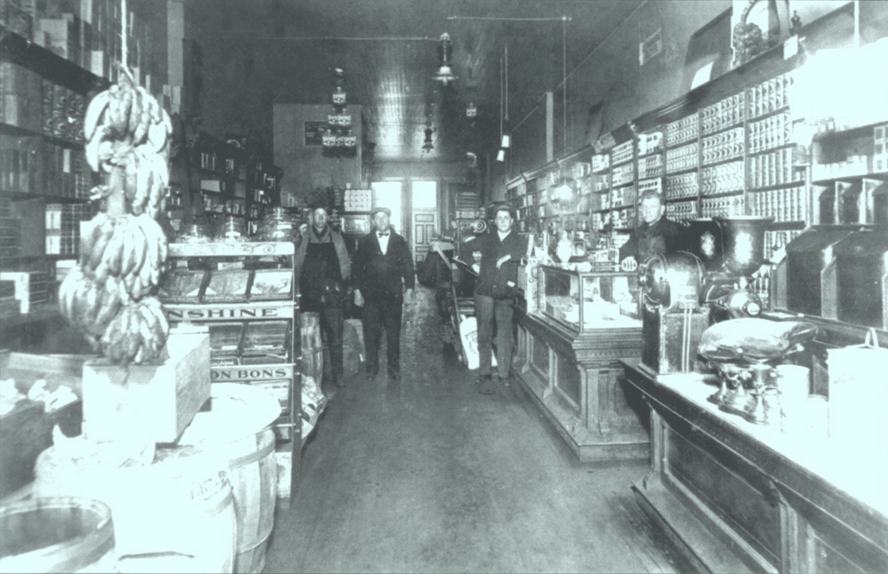
Fandel & Nugent, 1893

Edelbrock’s Dry Goods, 1877

Store Clerk
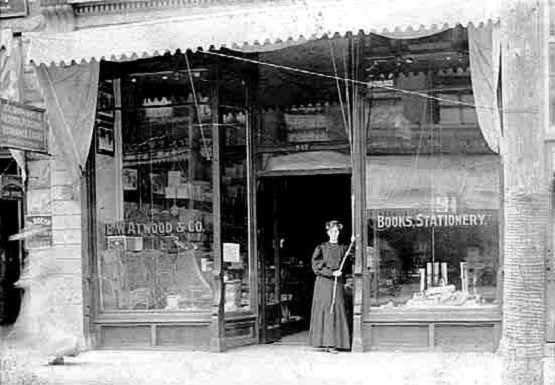
Dog & Pony Show, c. 1890

Julius Adams’ Cigar Factory furnished
employment to enough people around
the turn of the century to produce one
million cigars and 20 brands during the
year of 1903 (SCHS)


Hook & Ladder Co, 1877

Elephant Parade
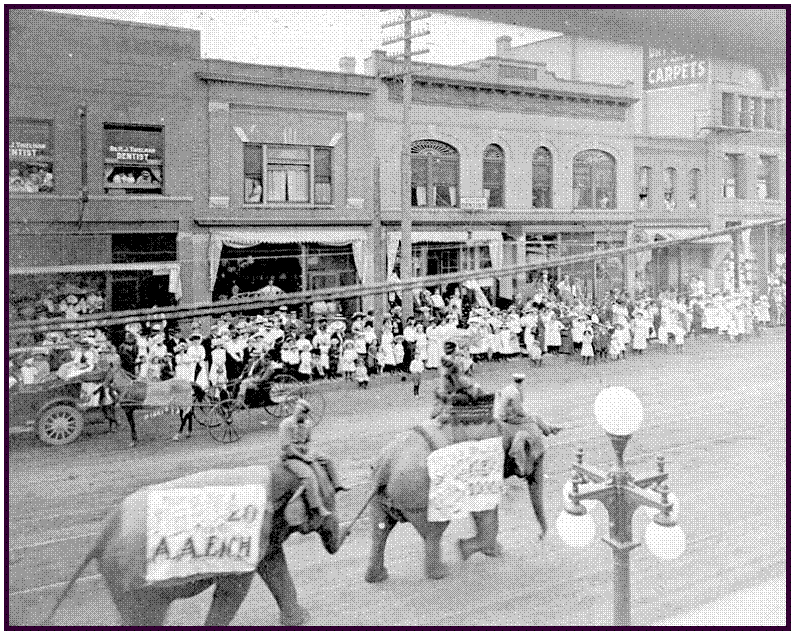
Dancing Bears on Germain & 6th, c. 1905

A section of the mural painted by David
Granham as a WPA project in 1938. It
was hung in the old post office, then the
Federal Building, soon to be reproduced
for the lobby once again. The Federal
Building is now owned and occupied by
Netgain Technology.


